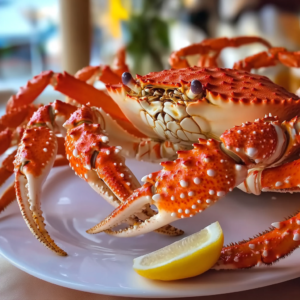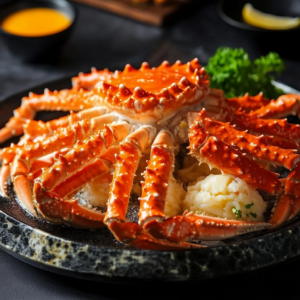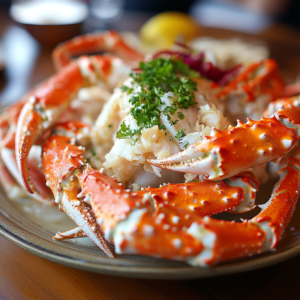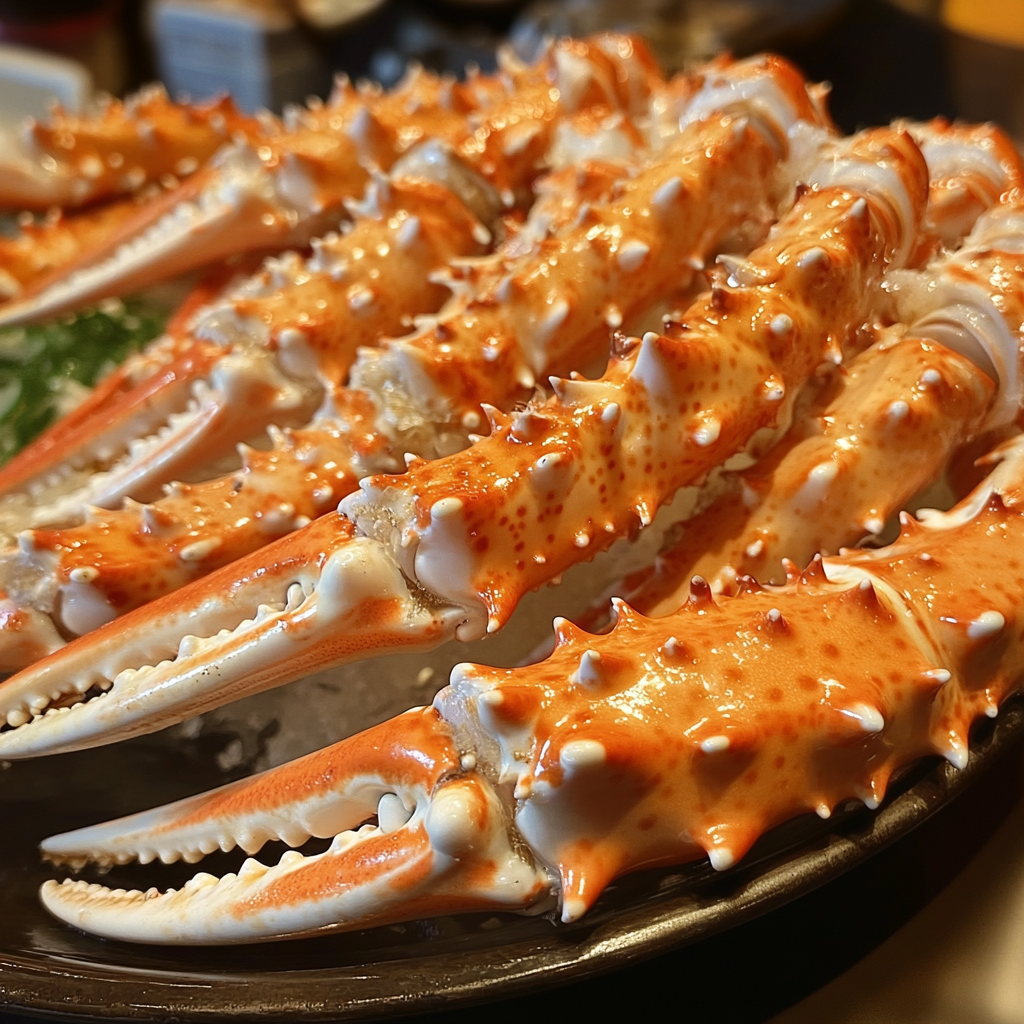When it comes to seafood, few crustaceans are as revered as king crab. Known for its colossal size, deliciously sweet meat, and health benefits, crab reigns supreme in the world of seafood. Whether you’re a seafood enthusiast or someone who only enjoys it occasionally, king crab stands out among its peers for several reasons. In this comprehensive article, we’ll explore why crab is considered superior to other crabs, its nutritional advantages, how it compares to other seafood, and much more.
1. What Makes King Crab Stand Out?
There are many reasons why king crab is often hailed as the best among all crab species.
Unique Size and Structure
King crab is known for its gigantic size, especially its legs. A single crab can weigh up to 10 kilograms, and its legs can span up to 6 feet across. This means there is a lot more meat in each leg compared to other crab species. Additionally, the thick, spiny shell of crab makes it easier to handle while cooking or serving, ensuring the meat stays juicy and tender.
Sweet, Tender Meat
The flavor profile of crab is another major factor in its superiority. The meat is naturally sweet and has a delicate texture that is different from other seafood. Its tender and succulent meat is often preferred by seafood lovers because of its melt-in-the-mouth quality. When compared to snow crab or Dungeness crab, crab stands out with a firmer texture and a more intense flavor.
Moreover, the unique environment where crabs are harvested—typically the icy waters of the Bering Sea—helps to impart a distinctively clean, sweet flavor. This is why many consider it one of the finest seafood options available. According to research, sustainable seafood practices ensure that the delicate balance in marine ecosystems is maintained, preserving this delicious delicacy for future generations. You can learn more about the sustainability of seafood from this source.
2. Health Benefits of King Crab
Eating king crab doesn’t just satisfy your taste buds, it’s also a great choice for your health. Here are some of the top health benefits:
- High Protein Content
For those looking to build muscle or maintain a high-protein diet, king crab is an excellent choice. A 100g serving contains about 19 grams of protein, making it a protein-rich option that’s also low in fat. - Low in Calories, Rich in Nutrients
Despite its rich taste, king crab is low in calories. A single serving contains approximately 82 calories, making it an excellent food for those looking to maintain or lose weight. - Packed with Omega-3 Fatty Acids
King crab is also a great source of omega-3 fatty acids, which are essential for heart health, reducing inflammation, and improving brain function. Studies show that regularly eating seafood rich in omega-3s can lower the risk of chronic diseases, including heart disease. You can read more about the benefits of omega-3s here. - Rich in Vitamins and Minerals
King crab is also a powerhouse of essential nutrients like selenium, zinc, and vitamin B12. These are crucial for immune function, metabolism, and overall cellular health. Selenium, in particular, helps in DNA synthesis and protecting cells from damage, making king crab a superfood in its own right.
3. King Crab vs Other Crabs

There are many different types of crab, but king crab consistently ranks at the top. Here’s a comparison between king crab and other popular crab varieties.
King Crab vs Snow
Snow crab is another popular species, but when compared to king crab, there are several notable differences:
- Size: Snow crabs are smaller, with thinner legs and less meat.
- Flavor: While snow crab is milder and slightly salty, king crab offers a richer, sweeter taste that is generally preferred by seafood connoisseurs.
- Texture: The texture of king crab meat is firmer, which helps it hold up better in various cooking methods such as grilling or baking.
King Crab vs Dungeness
Dungeness crab is often celebrated for its flavor, but it still falls short of the grandeur offered by crab:
- Size and Meat Yield: Dungeness crabs are smaller in size, which means less meat compared to crab. While Dungeness meat is flavorful, it lacks the sheer volume that crab provides.
- Ease of Cooking: Due to its larger size and thicker shell, crab is easier to cook and serve, especially when preparing dishes for a crowd.
4. Why is King Crab More Expensive?
Anyone who has purchased crab knows that it often comes with a higher price tag than other seafood. But there are several reasons why this is the case:
Harvesting Challenges
King crab fishing is a dangerous and labor-intensive task. Crabs are typically harvested in the freezing waters of the Bering Sea, and fishers face harsh weather conditions, icy seas, and the risk of injury. This hazardous nature of the job drives up the cost of king crab, as fishermen must be compensated fairly for their efforts.
Limited Supply and High Demand
Because of its seasonal nature and the fact that king crab populations are managed to prevent overfishing, the supply of king crab is often limited. At the same time, demand for this premium seafood remains high around the world, contributing to its elevated price.
Seasonal Availability
The king crab season typically runs from October to January, meaning that for much of the year, fresh king crab isn’t available. The limited availability during the off-season drives up the price, especially when king crab is in demand for special occasions like the holidays. For more information on king crab fishing regulations, check this source.
5. Cooking and Serving
When it comes to preparing king crab, there are several ways to make sure you’re getting the most out of this delicious seafood. Whether you’re a culinary expert or a home cook, king crab is incredibly versatile and easy to work with.
Boiling
One of the simplest and most popular methods for cooking king crab is boiling.
- Fill a large pot with water, add salt, and bring it to a boil.
- Submerge the king crab legs and cook for 5-7 minutes, or until heated through.
- Serve with melted butter and lemon wedges for a classic experience.
Steaming King Crab
Steaming is another great way to cook king crab, as it helps retain moisture and flavor.
- Place the king crab legs in a steamer basket over boiling water.
- Steam for 6-8 minutes until fully heated.
- Pair with garlic butter or a spicy aioli for a delicious seafood treat.
Grilling
If you’re looking to add some extra flavor to your king crab, grilling is an excellent option.
- Preheat the grill to medium-high.
- Brush the king crab legs with olive oil, salt, and pepper.
- Grill for 5-7 minutes on each side, basting occasionally with garlic butter for a smoky, savory finish.
Baking
Baking king crab allows for even heating and is perfect for large gatherings.
- Preheat the oven to 350°F.
- Place the king crab legs on a baking sheet and brush with melted butter and minced garlic.
- Bake for 15-20 minutes, or until heated through and slightly crispy.
6. Choosing Quality

Selecting the best quality king crab is essential to ensure you’re getting the full experience of this delicious seafood. Whether you’re purchasing fresh or frozen, here are some important tips to help you choose the highest quality king crab for your meal.
Fresh vs. Frozen
One of the most common ways to purchase crab is frozen. This is because king crab is often harvested in remote, cold locations like the Bering Sea, and freezing the crab shortly after catching preserves its freshness. However, if you have access to fresh king crab, it’s always an excellent choice.
- Frozen King Crab: If buying frozen, look for king crab legs that have been flash-frozen immediately after harvest. This preserves the texture and flavor of the meat. Avoid any packaging that looks damaged, has excessive frost, or appears discolored, as these are signs of poor quality or improper storage.
- Fresh King Crab: Fresh crab is less common due to the remote regions where it is caught, but if you can find it, the quality is unmatched. Fresh king crab should have a clean, oceanic scent without a strong “fishy” odor, and the meat should be moist and firm.
Check the Color and Smell
- Color: When buying frozen or pre-cooked crab, the shell should be a bright, vibrant red or orange color. This indicates that it has been properly cooked and frozen. Any dull or faded shells may indicate poor storage or handling, which can affect the flavor and texture of the meat.
- Smell: A fresh seafood smell is a good indicator of quality. crab should smell clean and slightly briny, much like the ocean. If the crab smells overly fishy or sour, it’s best to avoid it as this could indicate it’s not fresh or has gone bad.
Shell Integrity
When selecting crab, inspect the legs carefully. The shell should be intact, with no cracks or splits. Cracked or broken shells can expose the meat to air, leading to freezer burn or drying out during cooking.
Check for Meat Content
- Meat-to-Shell Ratio: Look for crab legs that feel heavy for their size. Heavier legs generally contain more meat. While som crab species, such as the red crab, have thicker, meatier legs, others, like the golden crab, might have slightly less meat, even though they are still delicious.
- Avoid Waterlogged Crab: Some froze crab legs may have been injected with water to increase weight. This results in a soggy texture when cooked. To avoid this, look for reputable seafood suppliers or brands known for quality.
Buy from Reputable Sources
Finally, always buy your crab from trusted and reputable seafood markets or online suppliers. Reputable sellers will often provide detailed information about the origin of the crab, the harvesting methods, and how it was processed and stored. This ensures that you’re getting high-quality crab that has been handled with care.
Conclusion
In conclusion, crab remains the pinnacle of premium seafood for many reasons. Its unique size, sweet and tender meat, and high nutritional value make it a favorite among seafood lovers worldwide. Whether you’re enjoying it in a restaurant or preparing it at home, crab offers a dining experience that few other crabs can match.

Despite its higher price, the benefits of king its health benefits, including high protein and omega-3 fatty acids, to its versatility in the kitchen—make it well worth the investment. Additionally, the stringent sustainability practices around crab fishing ensure that future generations will continue to enjoy this delicious crustacean.
When choosing between different types of crab, consistently comes out on top. Its larger size, firmer texture, and richer flavor make it superior to snow , Dungeness crab, and other varieties. Plus, with several cooking methods available—whether you prefer boiling, steaming, grilling, or baking—you can always find a way to bring out the best in this remarkable seafood.
Ultimately, crab is more than just a meal; it’s a luxurious culinary experience that is perfect for special occasions or an indulgent treat. So next time you’re deciding on seafood, remember why crab is better—it offers unmatched flavor, health benefits, and a sustainability-conscious choice that truly makes it the crabs.

